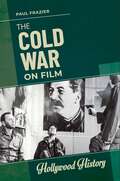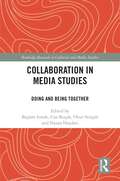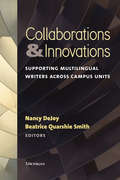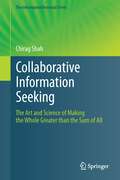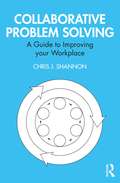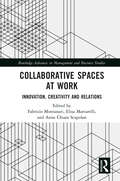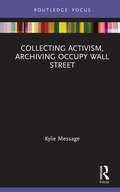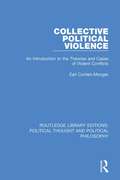- Table View
- List View
The Cold War on Film (Hollywood History)
by Paul FrazierThe Cold War on Film illustrates how to use film as a teaching tool. It stands on its own as an account of both the war and the major films that have depicted it.Memories of the Cold War have often been shaped by the popular films that depict it—for example, The Manchurian Candidate, The Hunt for Red October, and Charlie Wilson's War, among others. The Cold War on Film examines how the Cold War has been portrayed through a selection of 10 iconic films that represent it through dramatization and storytelling, as opposed to through documentary footage.The book includes an introduction to the war's history and a timeline of events. Each of the 10 chapters that follow focuses on a specific Cold War film. Chapters offer a uniquely detailed level of historical context for the films, weighing their depiction of events against the historical record and evaluating how well or how poorly those films reflected the truth and shaped public memory and discourse over the war. A comprehensive annotated bibliography of print and electronic sources aids students and teachers in further research.
The Cold War on Film (Hollywood History)
by Paul FrazierThe Cold War on Film illustrates how to use film as a teaching tool. It stands on its own as an account of both the war and the major films that have depicted it.Memories of the Cold War have often been shaped by the popular films that depict it—for example, The Manchurian Candidate, The Hunt for Red October, and Charlie Wilson's War, among others. The Cold War on Film examines how the Cold War has been portrayed through a selection of 10 iconic films that represent it through dramatization and storytelling, as opposed to through documentary footage.The book includes an introduction to the war's history and a timeline of events. Each of the 10 chapters that follow focuses on a specific Cold War film. Chapters offer a uniquely detailed level of historical context for the films, weighing their depiction of events against the historical record and evaluating how well or how poorly those films reflected the truth and shaped public memory and discourse over the war. A comprehensive annotated bibliography of print and electronic sources aids students and teachers in further research.
Collaboration in Media Studies: Doing and Being Together (Routledge Research in Cultural and Media Studies)
by Begüm Irmak Can Koçak Onur Sesigür Nazan HaydariThis volume offers new perspectives on knowledge production through various forms of togetherness. Via diverse cases of collaboration in media studies, from methodological contemplations to on‑the‑field social practices, the book proposes reflections and inquiries around collective research, media, and action.The collection rethinks how scholarly endeavours feature different ways of doing and being together, identifying new and more diverse communicative spaces, challenging dichotomies, and encouraging critical perspectives. Scholars of a variety of disciplines recontextualise collaboration beyond the very nature of conventional academic approaches, to embrace vast connotations of media studies – from actions building connections across research and practice to transdisciplinary methodologies through analogue and digital realms.This book will be an invaluable resource for scholars and post‑graduate students from various fields of media studies, who carry an interest in collaborative and collective aspects of media as practice and research, as well as those in a variety of social science disciplines, participatory action research, media sociology, audience studies, intercultural communication, qualitative research methods, and participatory communication.
Collaboration in Media Studies: Doing and Being Together (Routledge Research in Cultural and Media Studies)
by Begüm Irmak Can Koçak Onur Sesigür Nazan HaydariThis volume offers new perspectives on knowledge production through various forms of togetherness. Via diverse cases of collaboration in media studies, from methodological contemplations to on‑the‑field social practices, the book proposes reflections and inquiries around collective research, media, and action.The collection rethinks how scholarly endeavours feature different ways of doing and being together, identifying new and more diverse communicative spaces, challenging dichotomies, and encouraging critical perspectives. Scholars of a variety of disciplines recontextualise collaboration beyond the very nature of conventional academic approaches, to embrace vast connotations of media studies – from actions building connections across research and practice to transdisciplinary methodologies through analogue and digital realms.This book will be an invaluable resource for scholars and post‑graduate students from various fields of media studies, who carry an interest in collaborative and collective aspects of media as practice and research, as well as those in a variety of social science disciplines, participatory action research, media sociology, audience studies, intercultural communication, qualitative research methods, and participatory communication.
Collaborations & Innovations: Supporting Multilingual Writers across Campus Units
by DeJoy Nancy Smith Beatrice QuarshieFor decades, U.S. institutions of higher education have discussed ways to meet the needs of multilingual students; the more recent increases in enrollment by international students have created opportunities for productive change across campuses—particularly ways that units can collaborate to better meet those needs. The chapters in this volume demonstrate that teaching effective communication skills to all students in ways that recognize the needs of multiple language users requires a shift in perspective that approaches multilingualism as an opportunity that is enhanced by the internationalization of higher education because it makes transparent the problems of current structures and disciplinary approaches in accessing those opportunities. A goal of this collection is to address the economic, structural, disciplinary, and pedagogical challenges of making this type of shift in bold and compassionate ways. Chapters are organized into these four parts--Program-Level Challenges and Opportunities, Opportunities for Enhancing Teacher Training, Multilingualism and the Revision of First-Year Writing, and Integrating Writing Center Insights—and reflect the perspectives of a variety of university language settings. The contributions feature collaborative models and illustrate the need to rethink structures, pedagogies, assessment/evaluation processes, and teacher training for graduate and undergraduate students who will teach writing and other forms of communication.
Collaborative Design and Planning for Digital Manufacturing
by Lihui Wang Andrew Yeh Ching NeeCollaborative design has attracted much attention in the research community in recent years. With increasingly decentralized manufacturing systems and processes, more collaborative approaches and systems are needed to support distributed manufacturing operations. "Collaborative Design and Planning for Digital Manufacturing" presents a focused collection of quality chapters on the state-of-the-art research efforts in the area of collaborative design and planning, as well as their practical applications towards digital manufacturing. "Collaborative Design and Planning for Digital Manufacturing" provides both a broad-based review of the key areas of research in digital manufacturing, and an in-depth treatment of particular methodologies and systems, from collaborative design to distributed planning, monitoring and control. Recent development and innovations in this area provide a pool of focused research efforts, relevant to a wide readership from academic researchers to practicing engineers.
Collaborative Information Seeking: The Art and Science of Making the Whole Greater than the Sum of All (The Information Retrieval Series #34)
by Chirag ShahToday’s complex, information-intensive problems often require people to work together. Mostly these tasks go far beyond simply searching together; they include information lookup, sharing, synthesis, and decision-making. In addition, they all have an end-goal that is mutually beneficial to all parties involved. Such “collaborative information seeking” (CIS) projects typically last several sessions and the participants all share an intention to contribute and benefit. Not surprisingly, these processes are highly interactive.Shah focuses on two individually well-understood notions: collaboration and information seeking, with the goal of bringing them together to show how it is a natural tendency for humans to work together on complex tasks. The first part of his book introduces the general notions of collaboration and information seeking, as well as related concepts, terminology, and frameworks; and thus provides the reader with a comprehensive treatment of the concepts underlying CIS. The second part of the book details CIS as a standalone domain. A series of frameworks, theories, and models are introduced to provide a conceptual basis for CIS. The final part describes several systems and applications of CIS, along with their broader implications on other fields such as computer-supported cooperative work (CSCW) and human-computer interaction (HCI).With this first comprehensive overview of an exciting new research field, Shah delivers to graduate students and researchers in academia and industry an encompassing description of the technologies involved, state-of-the-art results, and open challenges as well as research opportunities.
Collaborative Intelligence: The New Way to Bring Out the Genius, Fun, and Productivity in Any Team
by Mariano Battan Jim KalbachCreate better connected teams and hold more productive meetings In Collaborative Intelligence: Design Better Collaboration, Improve Team Productivity, and Build a Culture of Connection, the workplace collaboration experts at MURAL offer a holistic and comprehensive system for fixing today’s broken teamwork culture. This book introduces the emerging practice of collaboration design, a cutting-edge approach to crafting collaborative experiences with a high degree of intentionality so that they deliver extraordinary, repeatable outcomes. With a strong focus on activities and rituals that can be used by leaders and team members right now, the authors show businesses how they can innovate faster than ever. Readers will learn the skills they need to enable better collaboration, whether their teams are hybrid, remote, in-person, synchronous, or asynchronous. Based on decades of research, experience, and observations from working with thousands of teams globally in all kinds of collaboration spaces, this highly visual book provides the instruction you need to fix teamwork, transform your organization, and re-imagine what’s possible at work. You’ll also find: How to build playbooks of collaboration methods How to create an inclusive, equitable, and collaborative environment that invites participation and unlocks the genius of your teams How to access unprecedented insights into how collaboration happens in your organization Strategies for leading collaboration change at the organization levelA can’t-miss guide for knowledge-work professionals, Collaborative Intelligence provides the direction you’ve been looking for to help teams innovate together.
Collaborative Intelligence: The New Way to Bring Out the Genius, Fun, and Productivity in Any Team
by Mariano Battan Jim KalbachCreate better connected teams and hold more productive meetings In Collaborative Intelligence: Design Better Collaboration, Improve Team Productivity, and Build a Culture of Connection, the workplace collaboration experts at MURAL offer a holistic and comprehensive system for fixing today’s broken teamwork culture. This book introduces the emerging practice of collaboration design, a cutting-edge approach to crafting collaborative experiences with a high degree of intentionality so that they deliver extraordinary, repeatable outcomes. With a strong focus on activities and rituals that can be used by leaders and team members right now, the authors show businesses how they can innovate faster than ever. Readers will learn the skills they need to enable better collaboration, whether their teams are hybrid, remote, in-person, synchronous, or asynchronous. Based on decades of research, experience, and observations from working with thousands of teams globally in all kinds of collaboration spaces, this highly visual book provides the instruction you need to fix teamwork, transform your organization, and re-imagine what’s possible at work. You’ll also find: How to build playbooks of collaboration methods How to create an inclusive, equitable, and collaborative environment that invites participation and unlocks the genius of your teams How to access unprecedented insights into how collaboration happens in your organization Strategies for leading collaboration change at the organization levelA can’t-miss guide for knowledge-work professionals, Collaborative Intelligence provides the direction you’ve been looking for to help teams innovate together.
Collaborative Leadership in Financial Services
by Philip UllahToday's leader needs to be equipped with the tools and skills to find an effective way to collaborate with others. Global organizations today are highly complex, involving multiple parties, offshore operations, and matrix management structures. Leaders can only successfully deliver their strategic goals if they have the ability to build collaboration across the silos these create. Collaborative Leadership in Financial Services is a practical guide which focuses on technologists within investment banking and capital markets. It is intended for everyone within the hierarchy of an organization whose collaboration is essential for the smooth running of a technology operation with many stakeholders. It shows how to improve leadership by explaining how to make this collaboration successful and effective.
Collaborative Leadership in Financial Services
by Philip UllahToday's leader needs to be equipped with the tools and skills to find an effective way to collaborate with others. Global organizations today are highly complex, involving multiple parties, offshore operations, and matrix management structures. Leaders can only successfully deliver their strategic goals if they have the ability to build collaboration across the silos these create. Collaborative Leadership in Financial Services is a practical guide which focuses on technologists within investment banking and capital markets. It is intended for everyone within the hierarchy of an organization whose collaboration is essential for the smooth running of a technology operation with many stakeholders. It shows how to improve leadership by explaining how to make this collaboration successful and effective.
Collaborative Problem Solving: A Guide to Improving your Workplace
by Chris J. ShannonDrawing on knowledge from process improvement, organisation theory, human resource management, change management, occupational health and safety, and other fields, the book is a practical, easy-to-read guide to problem solving. Illustrated with a series of short case studies, this book provides an integrated approach to problem solving in the workplace. Collaborative Problem Solving walks through the steps in the problem solving process, introducing dozens of tools, techniques, and concepts to use throughout. Chris J. Shannon describes the behaviours to practice which are most conducive to creating a positive problem solving culture based on curiosity, collaboration, and evidence-based thinking. This book explains why successful problem solving is a collaborative process and provides tools and techniques for responding to other people’s behaviour when designing and implementing solutions. Offering practical advice on problem solving in an easy-to-understand way, this book is aimed at people working in office environments, service industries, and knowledge organisations, enabling them to feel confident in applying the knowledge from the book in their own workplace.
Collaborative Problem Solving: A Guide to Improving your Workplace
by Chris J. ShannonDrawing on knowledge from process improvement, organisation theory, human resource management, change management, occupational health and safety, and other fields, the book is a practical, easy-to-read guide to problem solving. Illustrated with a series of short case studies, this book provides an integrated approach to problem solving in the workplace. Collaborative Problem Solving walks through the steps in the problem solving process, introducing dozens of tools, techniques, and concepts to use throughout. Chris J. Shannon describes the behaviours to practice which are most conducive to creating a positive problem solving culture based on curiosity, collaboration, and evidence-based thinking. This book explains why successful problem solving is a collaborative process and provides tools and techniques for responding to other people’s behaviour when designing and implementing solutions. Offering practical advice on problem solving in an easy-to-understand way, this book is aimed at people working in office environments, service industries, and knowledge organisations, enabling them to feel confident in applying the knowledge from the book in their own workplace.
Collaborative Spaces at Work: Innovation, Creativity and Relations (Routledge Advances in Management and Business Studies)
by Fabrizio Montanari Elisa Mattarelli Anna Chiara ScapolanCollaborative spaces are more than physical locations of work and production. They present strong identities centered on collaboration, exchange, sense of community, and co-creation, which are expected to create a physical and social atmosphere that facilitates positive social interaction, knowledge sharing, and information exchange. This book explores the complex experiences and social dynamics that emerge within and between collaborative spaces and how they impact, sometimes unexpectedly, on creativity and innovation. Collaborative Spaces at Work is timely and relevant: it will address the gap in critical understandings of the role and outcomes of collaborative spaces. Advancing the debate beyond regional development rhetoric, the book will investigate, through various empirical studies, if and how collaborative spaces do actually support innovation and the generation of new ideas, products, and processes. The book is intended as a primary reference in creativity and innovation, workspaces, knowledge and creative workers, and urban studies. Given its short chapters and strong empirical orientation, it will also appeal to policy makers interested in urban regeneration, sustaining innovation, and social and economic development, and to managers of both collaborative spaces and companies who want to foster creativity within larger organizations. It can also serve as a textbook in master’s degrees and PhD courses on innovation and creativity, public management, urban studies, management of work, and labor relations.
Collaborative Spaces at Work: Innovation, Creativity and Relations (Routledge Advances in Management and Business Studies)
by Fabrizio Montanari Elisa Mattarelli Anna Chiara ScapolanCollaborative spaces are more than physical locations of work and production. They present strong identities centered on collaboration, exchange, sense of community, and co-creation, which are expected to create a physical and social atmosphere that facilitates positive social interaction, knowledge sharing, and information exchange. This book explores the complex experiences and social dynamics that emerge within and between collaborative spaces and how they impact, sometimes unexpectedly, on creativity and innovation. Collaborative Spaces at Work is timely and relevant: it will address the gap in critical understandings of the role and outcomes of collaborative spaces. Advancing the debate beyond regional development rhetoric, the book will investigate, through various empirical studies, if and how collaborative spaces do actually support innovation and the generation of new ideas, products, and processes. The book is intended as a primary reference in creativity and innovation, workspaces, knowledge and creative workers, and urban studies. Given its short chapters and strong empirical orientation, it will also appeal to policy makers interested in urban regeneration, sustaining innovation, and social and economic development, and to managers of both collaborative spaces and companies who want to foster creativity within larger organizations. It can also serve as a textbook in master’s degrees and PhD courses on innovation and creativity, public management, urban studies, management of work, and labor relations.
Collaborative Translation: From the Renaissance to the Digital Age (Bloomsbury Advances in Translation)
by Anthony Cordingley Céline Frigau ManningFor centuries, the art of translation has been misconstrued as a solitary affair. Yet, from Antiquity to the Middle Ages, groups of translators comprised of specialists of different languages formed in order to transport texts from one language and culture to another. Collaborative Translation uncovers the collaborative practices occluded in Renaissance theorizing of translation to which our individualist notions of translation are indebted. Leading translation scholars as well as professional translators have been invited here to detail their experiences of collaborative translation, as well as the fruits of their research into this neglected form of translation.This volume offers in-depth analysis of rich, sometimes explosive, relationships between authors and their translators. Their negotiations of cooperation and control, assistance and interference, are shown here to shape the translation of prominent modern authors such as Günter Grass, Vladimir Nabokov and Haruki Murakami.The advent of printing, the cultural institutions and the legal and political environment that regulate the production of translated texts have each formalized many of the inherently social and communicative practices of translation. Yet this publishing regime has been profoundly disrupted by the technologies that are currently revolutionizing collaborative translation techniques. This volume details the impact that this technological and environmental evolution is having upon the translator, proliferating sites and communities of collaboration, transforming traditional relationships with authors and editors, revisers, stage directors, actors and readers.
Collaborative Translation: From the Renaissance to the Digital Age (Bloomsbury Advances in Translation)
by Anthony Cordingley Céline Frigau ManningFor centuries, the art of translation has been misconstrued as a solitary affair. Yet, from Antiquity to the Middle Ages, groups of translators comprised of specialists of different languages formed in order to transport texts from one language and culture to another. Collaborative Translation uncovers the collaborative practices occluded in Renaissance theorizing of translation to which our individualist notions of translation are indebted. Leading translation scholars as well as professional translators have been invited here to detail their experiences of collaborative translation, as well as the fruits of their research into this neglected form of translation.This volume offers in-depth analysis of rich, sometimes explosive, relationships between authors and their translators. Their negotiations of cooperation and control, assistance and interference, are shown here to shape the translation of prominent modern authors such as Günter Grass, Vladimir Nabokov and Haruki Murakami.The advent of printing, the cultural institutions and the legal and political environment that regulate the production of translated texts have each formalized many of the inherently social and communicative practices of translation. Yet this publishing regime has been profoundly disrupted by the technologies that are currently revolutionizing collaborative translation techniques. This volume details the impact that this technological and environmental evolution is having upon the translator, proliferating sites and communities of collaboration, transforming traditional relationships with authors and editors, revisers, stage directors, actors and readers.
Collaborative Web Hosting: Challenges and Research Directions (SpringerBriefs in Computer Science)
by Reaz Ahmed Raouf BoutabaThis brief presents a peer-to-peer (P2P) web-hosting infrastructure (named pWeb) that can transform networked, home-entertainment devices into lightweight collaborating Web servers for persistently storing and serving multimedia and web content. The issues addressed include ensuring content availability, Plexus routing and indexing, naming schemes, web ID, collaborative web search, network architecture and content indexing. In pWeb, user-generated voluminous multimedia content is proactively uploaded to a nearby network location (preferably within the same LAN or at least, within the same ISP) and a structured P2P mechanism ensures Internet accessibility by tracking the original content and its replicas. This new paradigm of information management strives to provide low or no-cost cloud storage and entices the end users to upload voluminous multimedia content to the cloud data centers. However, it leads to difficulties in privacy, network architecture and content availability. Concise and practical, this brief examines the benefits and pitfalls of the pWeb web-hosting infrastructure. It is designed for professionals and practitioners working on P2P and web management and is also a useful resource for advanced-level students studying networks or multimedia.
Collected Columns (Methuen Humour Ser.)
by Michael FraynOne of the funniest writers of his generation, Michael Frayn has been writing humorous newspaper columns since 1959, principally for the "Guardian" and "Observer", and originally came to prominence as the thrice weekly purveyor of these short, surreal, razor-sharp explorations of human foibles, sex, politics, manners, and the events of the day. This volume brings together 110 of his finest and funniest pieces from over the years, selected and introduced by Michael Frayn himself, and is an unmissable treat for the many fans of his unique comic voice, as well as a revelation for fans of the award-winning literary novels and plays of his later career.
Collecting Activism, Archiving Occupy Wall Street: Archiving Occupy Wall Street (Museums in Focus)
by Kylie MessageCollecting Activism, Archiving Occupy Wall Street explores the material collections produced by participants of Occupy Wall Street in 2011 that bear witness to the experience and agency of ‘the 99%’. Examining processes of collection development as a lens through which to investigate the sociology of protest and reform movements, the book questions what contribution a dual study of the material culture of dissent and the production of a collection hosting the material culture of dissent might offer to a range of disciplines and practices. It asks if and how a collections-based study can test the propositions, tactics, and limits of activism from archival, museological, and political perspectives. Collecting Activism, Archiving Occupy Wall Street draws from interdisciplinary fields, including museum studies, collection studies, archive studies, cultural studies, and public history. It will be a valuable resource for scholars and practitioners engaged with contemporary cause-based collecting, activist archiving, public history, and the cultural politics and sociology of social reform movements. It models strategies for ‘activating’ historical archives and collections-based data, and for engaging with autoethnographic records to represent and analyze the material residue of protest and reform movements today.
Collecting Activism, Archiving Occupy Wall Street: Archiving Occupy Wall Street (Museums in Focus)
by Kylie MessageCollecting Activism, Archiving Occupy Wall Street explores the material collections produced by participants of Occupy Wall Street in 2011 that bear witness to the experience and agency of ‘the 99%’. Examining processes of collection development as a lens through which to investigate the sociology of protest and reform movements, the book questions what contribution a dual study of the material culture of dissent and the production of a collection hosting the material culture of dissent might offer to a range of disciplines and practices. It asks if and how a collections-based study can test the propositions, tactics, and limits of activism from archival, museological, and political perspectives. Collecting Activism, Archiving Occupy Wall Street draws from interdisciplinary fields, including museum studies, collection studies, archive studies, cultural studies, and public history. It will be a valuable resource for scholars and practitioners engaged with contemporary cause-based collecting, activist archiving, public history, and the cultural politics and sociology of social reform movements. It models strategies for ‘activating’ historical archives and collections-based data, and for engaging with autoethnographic records to represent and analyze the material residue of protest and reform movements today.
Collective Behavior and Public Opinion: Rapid Shifts in Opinion and Communication (European Institute for the Media Series)
by Jaap van GinnekenThis is a highly innovative and stimulating work with the outline of an entirely new approach to massive and rapid shifts in opinion and communication. It discusses and explains such mysterious phenomena as sudden crazes and crashes, fads and fashion, hypes and manias, moral outrage and protests, gossip and rumors, and scares and panics. Rich in alternative insights, the book is divided into four parts. Part I discusses the points of departure: the most relevant processes of opinion formation and communication. Part II is about phenomena on three different levels, that have traditionally been studied within the twin fields of mass psychology and collective behavior sociology. Part III focuses on the three prime forms of "emotional coloring" of opinion currents and public moods. Part IV discusses a combination of some of the aforementioned phenomena: successive crazes and crashes in financial markets, and looks at why technological and economic, and social and opinion forecasts often fail so miserably. The audience for this book includes students of social and mass psychology, social movements and collective behavior sociology, and opinion and communication in general. Professionals in public relations, marketing, health, finance, and politics, as well as the educated lay audience, will also find this book of interest.
Collective Behavior and Public Opinion: Rapid Shifts in Opinion and Communication (European Institute for the Media Series)
by Jaap van GinnekenThis is a highly innovative and stimulating work with the outline of an entirely new approach to massive and rapid shifts in opinion and communication. It discusses and explains such mysterious phenomena as sudden crazes and crashes, fads and fashion, hypes and manias, moral outrage and protests, gossip and rumors, and scares and panics. Rich in alternative insights, the book is divided into four parts. Part I discusses the points of departure: the most relevant processes of opinion formation and communication. Part II is about phenomena on three different levels, that have traditionally been studied within the twin fields of mass psychology and collective behavior sociology. Part III focuses on the three prime forms of "emotional coloring" of opinion currents and public moods. Part IV discusses a combination of some of the aforementioned phenomena: successive crazes and crashes in financial markets, and looks at why technological and economic, and social and opinion forecasts often fail so miserably. The audience for this book includes students of social and mass psychology, social movements and collective behavior sociology, and opinion and communication in general. Professionals in public relations, marketing, health, finance, and politics, as well as the educated lay audience, will also find this book of interest.
Collective Political Violence: An Introduction to the Theories and Cases of Violent Conflicts (Routledge Library Editions: Political Thought and Political Philosophy #16)
by Earl Conteh-MorganFirst published in 2004. Collective Political Violence is a concise, but thorough, interdisciplinary analysis of the many competing concepts, theories, and explanations of political conflict, including revolutions, civil wars, genocide, and terrorism. To further his examination of each type of conflict, Earl Conteh-Morgan presents case studies, from the Rwandan genocide to the civil rights movement in the United States. Along the way, he illuminates new debates concerning terrorism, peacekeeping, and environmental security. Written in a knowledgeable, yet accessible, manner, Collective Political Violence treats the issue of political violence with on impressively wide geographic range, and successfully straddles the ideological divide.
Collective Political Violence: An Introduction to the Theories and Cases of Violent Conflicts (Routledge Library Editions: Political Thought and Political Philosophy #16)
by Earl Conteh-MorganFirst published in 2004. Collective Political Violence is a concise, but thorough, interdisciplinary analysis of the many competing concepts, theories, and explanations of political conflict, including revolutions, civil wars, genocide, and terrorism. To further his examination of each type of conflict, Earl Conteh-Morgan presents case studies, from the Rwandan genocide to the civil rights movement in the United States. Along the way, he illuminates new debates concerning terrorism, peacekeeping, and environmental security. Written in a knowledgeable, yet accessible, manner, Collective Political Violence treats the issue of political violence with on impressively wide geographic range, and successfully straddles the ideological divide.
